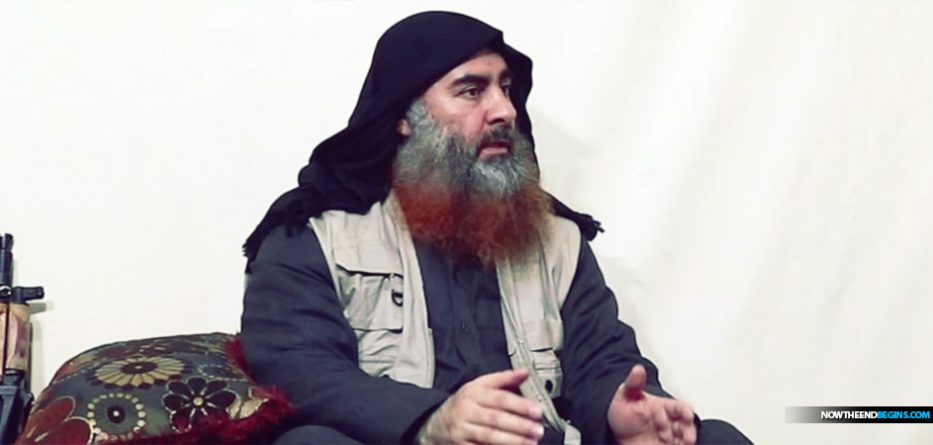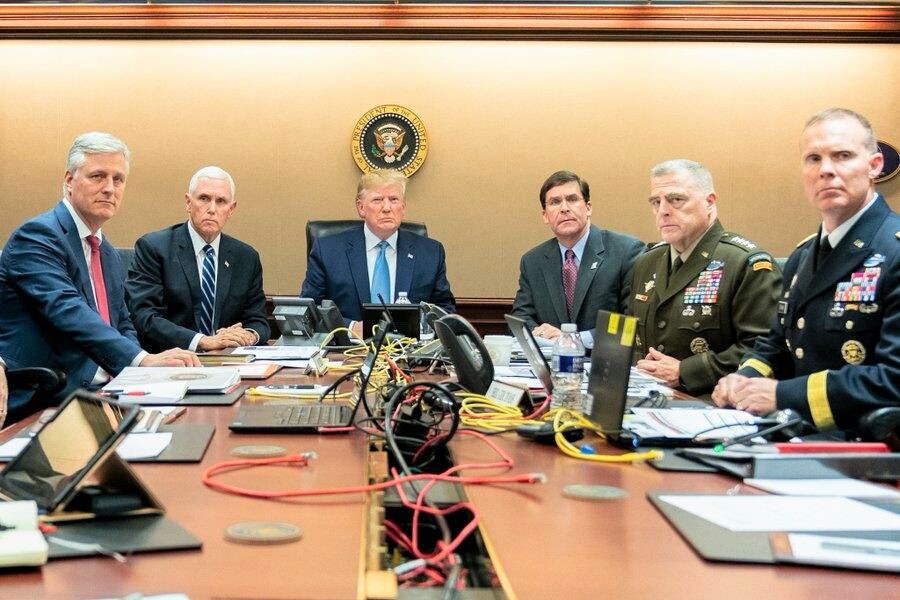
Trump’s Syria Troop Withdrawal Complicated Plans for al-Baghdadi Raid
Eric Schmitt, Helene Cooper and Julian E. Barnes / The New York Times
WASHINGTON (October 27, 2019) — President Trump knew the Central Intelligence Agency and Special Operations commandos were zeroing in on the location for Abu Bakr al-Baghdadi, the Islamic State leader, when he ordered American troops to withdraw from northern Syria earlier this month, intelligence, military and counterterrorism officials said on Sunday.
For months, intelligence officials had kept Mr. Trump apprised of what he had set as a top priority, the hunt for Mr. al-Baghdadi, the world’s most wanted terrorist.
But Mr. Trump’s abrupt withdrawal order three weeks ago disrupted the meticulous planning underway and forced Pentagon officials to speed up the plan for the risky night raid before their ability to control troops, spies and reconnaissance aircraft disappeared with the pullout, the officials said.
Mr. al-Baghdadi’s death in the raid on Saturday, they said, occurred largely in spite of, and not because of, Mr. Trump’s actions.
It is unclear how much Mr. Trump considered the intelligence on Mr. al-Baghdadi’s location when he made the surprise decision to withdraw the American troops during a telephone call on Oct. 6 with President Recep Tayyip Erdogan of Turkey. What is clear, military officials said, is that it put commanders on the ground under even more pressure to carry out the complicated operation.
More than a half-dozen Pentagon, military, intelligence and counterterrorism officials — along with Mr. Trump, who gave an account during a White House news conference on Sunday — provided a chronology of the raid.
The planning for the raid began this past summer, when the C.I.A. first got surprising information about Mr. al-Baghdadi’s general location in a village deep inside a part of northwestern Syria controlled by rival Qaeda groups. The information came after the arrest and interrogation of one of Mr. al-Baghdadi’s wives and a courier, two American officials said.
Armed with that initial tip, the C.I.A. worked closely with Iraqi and Kurdish intelligence officials in Iraq and Syria to identify more precisely Mr. al-Baghdadi’s whereabouts and to put spies in place to monitor his periodic movements. American officials said the Kurds continued to provide information to the C.I.A. on Mr. al-Baghdadi’s location even after Mr. Trump’s decision to withdraw the American troops left the Syrian Kurds to confront a Turkish offensive alone.
The Syrian and Iraqi Kurds, one official said, provided more intelligence for the raid than any single country.
According to a Syrian engineer who spoke with villagers living near the raid site, Mr. al-Baghdadi had sought shelter in the home of Abu Mohammed Salama, a commander of another extremist group, Hurras al-Din. The commander’s fate in that raid, and the precise nature of his relationship to Mr. al-Baghdadi, are not clear.
As the Army’s elite Delta Force commando unit began drawing up and rehearsing plans to conduct the mission to kill or capture the ISIS leader, they knew they faced formidable hurdles. The location was deep inside territory controlled by Al Qaeda. The skies over that part of the country were controlled by Syria and Russia.
The military called off missions at least twice at the last minute.
The final planning for the raid came together over two to three days last week. A senior administration official said that Mr. al-Baghdadi was “about to move.” Military officials determined that they had to go swiftly. If Mr. al-Baghdadi moved again, it would be much harder to track him with the American military pulling out its troops and surveillance assets on the ground in Syria.
By Thursday and then Friday, Defense Secretary Mark T. Esper said on ABC’s “This Week,” Mr. Trump “gave us the green light to proceed.’’
Around midnight Sunday morning in the region — 5 p.m. Saturday in Washington — eight American helicopters, primarily CH-47 Chinooks, took off from a military base near Erbil, Iraq.
Flying low and fast to avoid detection, the helicopters quickly crossed the Syrian border and then flew all the way across Syria itself — a dangerous 70-minute flight in which the helicopters took sporadic groundfire — to the Barisha area just north of Idlib city, in western Syria. Just before landing, the helicopters and other warplanes began firing on a compound of buildings, providing cover for commandos with the Delta Force and their military dogs to descend into a landing zone.
Mr. Trump said that with the helicopter gunships firing from above, the commandos had bypassed the front door, fearing a booby trap, before destroying one of the compound’s walls. That allowed them to rush through and confront a group of ISIS fighters.
The president, along with Mr. Esper, Vice President Mike Pence and Gen. Mark A. Milley, the chairman of the Joint Chiefs of Staff, watched video of the raid piped into the White House Situation Room from surveillance aircraft orbiting over the battlefield.
The Delta Force commandos, under fire, entered the compound, where they shot and killed a number of people. As the Delta Force team breached the wall with explosives, an Arabic linguist advised children and other noncombatants how to flee, a decision commanders credited with saving 11 of the children Mr. al-Baghdadi had in his compound.
Mr. al-Baghdadi ran into an underground tunnel, with the American commandos in pursuit. Mr. Trump said that the ISIS leader took three children with him, presumably to use as human shields from the American fire. Fearing that Mr. al-Baghdadi was wearing a suicide vest, the commandos dispatched a military dogto subdue Mr. al-Baghdadi, Mr. Trump said.
It was then that the Islamic State leader set off the explosives, killing the three children, Mr. Trump said.
Mr. Esper described the climax of the two-hour ground raid on “This Week” this way: “He’s in a compound, that’s right, with a few other men and women with him and a large number of children. Our special operators have tactics and techniques and procedures they go through to try and call them out. At the end of the day, as the president said, he decided to kill himself and took some small children with him, we believe.”
Mr. Trump was more descriptive. “I got to watch much of it,” he said. Mr. al-Baghdadi, he said, “died after running into a dead-end tunnel, whimpering and crying and screaming all the way.”
Mr. Esper did not repeat the “whimpering” and “crying” assertion made by Mr. Trump. “I don’t have those details,” he said. “The president probably had the opportunity to talk to the commanders on the ground.”
At 7:15 p.m. Washington time on Saturday, the Special Operations commander on the ground reported that Mr. al-Baghdadi had been killed. Five other “enemy combatants” were killed in the compound, the White House said, and “additional enemies were killed in the vicinity.”
Two American service members were slightly wounded, the White House said, but have returned to duty. The American military dog was wounded in Mr. al-Baghdadi’s suicide-vest explosion and was taken away, Mr. Trump said.
After the raid, the commandos removed the 11 children from the site and handed them over to a woman in the area. The military then ordered the destruction of the site, to ensure it would not in the future become a shrine to ISIS, according to a person familiar with the operation.
Altogether, the American troops were on the ground in the compound for around two hours, Mr. Trump said, clearing the buildings of fighters and scooping up information that the president said contained important details on ISIS operations. Mr. Trump said the commandos already had DNA samples from the Islamic State leader, which he said they used to make a quick assessment that they had the right man.
Once all the Americans had piled back into their helicopters and started the return flight to Iraq — using the same route out as they had used coming in, Mr. Trump said — American warplanes bombed the compound to ensure it was physically destroyed, Mr. Esper said. Just after 9 p.m. Washington time Saturday — four hours after the helicopters had taken off — Mr. Trump tweeted, “Something very big has just happened!”

THE DEATH OF A TERRORIST LEADER
ISIS Leader al-Baghdadi Is Dead, Trump Says, Oct. 27, 2019
Abu Bakr al-Baghdadi, ISIS Leader Known for His Brutality, Is Dead at 48, Oct. 27, 2019
How Commandos Could Quickly Confirm They Got Their Target, Oct. 27, 2019
Trump Says ‘Beautiful’ and ‘Talented’ Dog Injured in al-Baghdadi Raid, Oct. 27, 2019
Al-Baghdadi Raid Was a Victory Built on Factors Trump Derides
With al-Baghdadi Raid, Trump Makes the Made-for-TV Announcement He Has Long Wanted Oct. 27, 2019
Thomas Gibbons-Neff contributed reporting from Kabul, Afghanistan, and Rukmini Callimachi from Romania.
Eric Schmitt is a senior writer who has traveled the world covering terrorism and national security. He was also the Pentagon correspondent. A member of the Times staff since 1983, he has shared three Pulitzer Prizes. @EricSchmittNYT
Helene Cooper is a Pentagon correspondent. She was previously an editor, diplomatic correspondent and White House correspondent, and was part of the team awarded the 2015 Pulitzer Prize for International Reporting, for its coverage of the Ebola epidemic. @helenecooper
Julian E. Barnes is a national security reporter based in Washington, covering the intelligence agencies. Before joining The Times in 2018, he wrote about security matters for The Wall Street Journal.
Posted in accordance with Title 17, Section 107, US Code, for noncommercial, educational purposes.